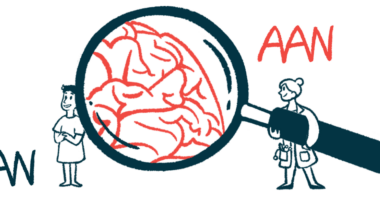Electrical Stimulation Device Assessed in Phase 2 Trial

A wearable neurostimulation device developed by NeuroMetrix is being investigated in a Phase 2 clinical trial as a potential pain-relieving treatment for people with neuromyelitis optica spectrum disorder (NMOSD).
The trial (NCT04614454) is expected to recruit 46 adult NMOSD participants who test positive for aquaporin-4 antibodies and who have been experiencing pain related to a spinal cord lesion for more than three months. Enrollment is ongoing at the Massachusetts General Hospital in Boston. More information about enrollment is available here.
Michael Levy, MD, PhD, director of the NMO Clinic and Research Laboratory at Mass Gen, will be the principal investigator for the trial.
“We are pleased to support Dr. Levy and his colleagues in this clinical trial. NMOSD is a disabling disease without safe and effective treatment options,” Shai N. Gozani, MD, PhD, president and CEO of NeuroMetrix, said in a press release.
In NMOSD, injury to the central nervous system may cause a variety of painful sensations that include burning, stabbing, and tingling in the upper body, arms, and legs.
NeuroMetrix developed a wearable device that uses painless transcutaneous electrical nerve stimulation (TENS) to relieve pain symptoms. These electrical impulses are thought to prevent pain messages from reaching the brain, although the exact mechanisms by which that happens are still largely unknown.
According to the company, TENS devices are considered safe and have been used by healthcare professions for decades to control pain.
NeuroMetrix developed its Quell wearable pain relief technology to alleviate pain in the knee, foot, and leg. The device is worn on the upper calf and can be connected to a mobile app that allows users to personalize stimulation patterns, therapy dosages, and sleep modes.
The ongoing clinical will use a modified version of the Quell device that can be placed on other locations and enable different stimulation patterns. A similar system is being tested for fibromyalgia (NCT04683042). It, too, is still recruiting participants.
In the NMOSD trial, participants will be assigned randomly to receive treatment (electrical impulses) with a Quell device for four weeks, or a sham machine. The device will be used at home for one hour per day.
Patients then will enter an open-label trial segment, during which all will receive the active treatment for an extra four weeks.
The trial’s main goal is to determine changes in pain scores in the first four weeks. This will be measured using the numerical rating score, in which zero represents no pain and 10 worst pain imaginable.
Secondary goals include changes in pain scores over the open-label phase, worst pain felt during the trial, and quality of life.
“This rigorous randomized controlled trial will add to the growing body of clinical data on the utility of Quell technology in chronic pain conditions with a neuropathic pain component. There are significant unmet clinical needs in the treatment of neuropathic pain that Quell may be able to eventually address,” Gozani added.






